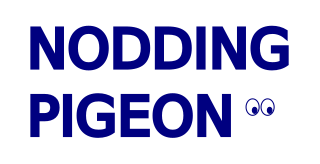The Nodding Pigeon library provides a pre-trained model and a simple inference API for detecting head gestures in short videos. Under the hood, it uses Google MediaPipe for collecting the landmark features.
Tested for Python 3.8, 3.9, and 3.10.
The best way to install this library with its dependencies is from PyPI:
python3 -m pip install --upgrade noddingpigeonAlternatively, to obtain the latest version from this repository:
git clone git@github.com:bhky/nodding-pigeon.git
cd nodding-pigeon
python3 -m pip install .An easy way to try the API and the pre-trained model is to make a short video with your head gesture.
The code snippet below will perform the following:
- Search for the pre-trained weights file from
$HOME/.noddingpigeon/weights/, if not exists, the file will be downloaded from this repository. - Start webcam.
- Collect the needed number of frames (default
60) for the model. - End webcam automatically (or you can press
qto end earlier). - Make prediction of your head gesture and print the result to STDOUT.
from noddingpigeon.inference import predict_video
result = predict_video()
print(result)
# Example result:
# {'gesture': 'nodding',
# 'probabilities': {'has_motion': 1.0,
# 'gestures': {'nodding': 0.9576354622840881,
# 'turning': 0.042364541441202164}}}Alternatively, you could provide a pre-recorded video file:
from noddingpigeon.inference import predict_video
from noddingpigeon.video import VideoSegment # Optional.
result = predict_video(
"your_head_gesture_video.mp4",
video_segment=VideoSegment.LAST, # Optionally change these parameters.
motion_threshold=0.5,
gesture_threshold=0.9
)Note that no matter how long your video is, only the
pre-defined number of frames (60 for the current model) are used for
prediction. The video_segment enum option controls how the frames
are obtained from the video,
e.g., VideoSegment.LAST means the last (60) frames will be used.
Thresholds can be adjusted as needed, see explanation in the head gestures section.
The result is returned as a Python dictionary.
{
'gesture': 'turning',
'probabilities': {
'has_motion': 1.0,
'gestures': {
'nodding': 0.009188028052449226,
'turning': 0.9908120036125183
}
}
}
The following gesture types are available:
nodding- Repeatedly tilt your head upward and downward.turning- Repeatedly turn your head leftward and rightward.stationary- Not tilting or turning your head; translation motion is still treated as stationary.undefined- Unrecognised gesture or no landmarks detected (usually means no face is shown).
To determine the final gesture:
- If
has_motionprobability is smaller thanmotion_threshold(default0.5),gestureisstationary. Other probabilities are irrelevant. - Otherwise, the largest probability from
gesturesis considered:- If it is smaller than
gesture_threshold(default0.9),gestureisundefined, - else, the corresponding gesture label is selected (e.g.,
nodding).
- If it is smaller than
- If no landmarks are detected in the video,
gestureisundefined. Theprobabilitiesdictionary is empty.
Detect head gesture shown in the input video either from webcam or file.
- Parameters:
video_path(Optional[str], defaultNone): File path to the video file, orNonefor starting a webcam.model(Optional[tf.keras.Model], defaultNone): A TensorFlow-Keras model instance, orNonefor using the default model.max_num_frames(int, default60): Maximum number of frames to be processed by the model. Do not change when using the default model.video_segment(VideoSegmentenum, defaultVideoSegment.BEGINNING): See explanation ofVideoSegment.end_padding(bool, defaultTrue): IfTrueandmax_num_framesis set, when the input video has not enough frames to form the feature tensor for the model, padding at the end will be done using the features detected on the last frame.drop_consecutive_duplicates(bool, defaultTrue): IfTrue, features from a certain frame will not be used to form the feature tensor if they are considered to be the same as the previous frame. This is a mechanism to prevent "fake" video created with static images.postprocessing(bool, defaultTrue): IfTrue, the final result will be presented as the Python dictionary described in the usage section, otherwise the raw model output is returned.motion_threshold(float, default0.5): See the head gestures section.gesture_threshold(float, default0.9): See the head gestures section.
- Return:
- A Python dictionary if
postprocessingisTrue, otherwiseList[float]from the model output.
- A Python dictionary if
Enum class for video segment options.
VideoSegment.BEGINNING: Collect the required frames for the model from the beginning of the video.VideoSegment.LAST: Collect the required frames for the model toward the end of the video.
Create an instance of the model used in this library, optionally with pre-trained weights loaded.
- Parameters:
weights_path(Optional[str], default$HOME/.noddingpigeon/weights/*.h5): Path to the weights in HDF5 format to be loaded by the model. The weights file will be downloaded if not exists. IfNone, no weights will be downloaded nor loaded to the model. Users can provide path if the default is not preferred. The environment variableNODDING_PIGEON_HOMEcan also be used to indicate where the.noddingpigeon/directory should be located.
- Return:
tf.keras.Modelobject.
Brief procedure:
- Record a few long-ish videos: one for each head gesture done repeatedly with as many variations as possible, and one for stationary.
- Landmark features in the videos are collected using MediaPipe.
- During model training, random sub-sequences from the feature collection, correspond to different video segments and gestures, are generated as training samples.
- This basically means that all samples generated, in each epoch, are very likely not the same as each other. This serves as a good regularization as well.
- A very simple 1D-convolutional model architecture is used to minimise overfitting.
For details, see the data collection and model training scripts in the training directory.

